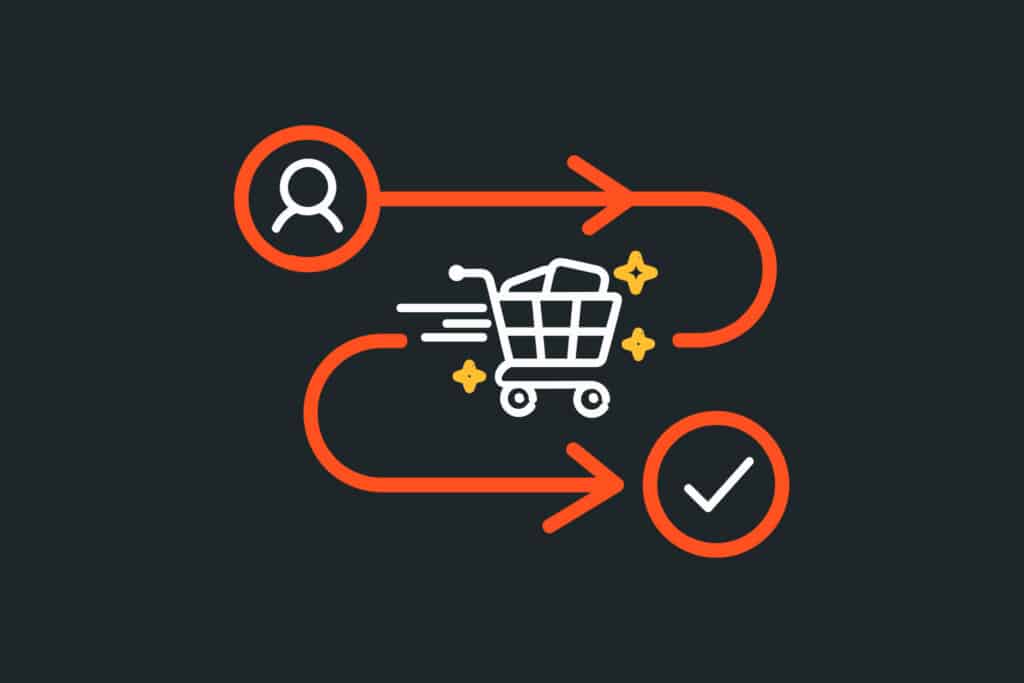Automation doesn’t have to be impersonal – find out how
Managing an eCommerce business often requires balancing several priorities at once. Automation is here to help you get it all done well.
Communicating effectively with your customers across multiple platforms, ensuring that your website content is functional and up-to-date, and finding ways to keep your existing customer base engaged. These are all critical areas to invest energy into, but these can be time-consuming. Whether you’re using WooCommerce, Shopify, or another platform, any Head of Ecommerce should automate processes.
Studies show that 49% of eCommerce businesses use some form of automated marketing communication. And advances in technology and AI mean you can automate key workflows whilst still providing a user experience that feels authentic and personal. There are many benefits to automation, such as:
- Saving businesses time
- Reducing strain on internal resources
- Helping you create more targeted campaigns
- Freeing up time for more creative and strategic thinking
- Increasing your revenue
In this blog post, we’re going to explore:
-
Personalisation
-
Product discovery
-
Product suggestions
-
Up-selling and cross-selling
-
SMS campaigns
-
Abandoned cart emails
-
Re-targeting
-
Order emails
-
Re-engagement flows
Insights straight to your inbox
The monthly newsletter you’ll be waiting for. Subscribe now for the latest news, guides and insights.
Everything a Head of Ecommerce should automate
eCommerce personalisation
Customers want to feel seen, heard and acknowledged by the businesses they choose to shop with. Studies show that 80% of customers are more likely to shop with brands that offer them personalised content.
For businesses with physical locations, staff can build this rapport through face-to face interactions. For instance, by using a friendly tone and body language, remembering details about regular customers and suggesting products that you know they’d like. These all contribute to a positive brand experience.
However, for eCommerce businesses that operate entirely online, it can be a challenge to replicate this type of experience when you aren’t interacting with customers in-person. Advances in artificial intelligence and email marketing software are useful here. Combining these, brands can achieve a similar impact digitally, even if they never interact with their customers face-to-face.
Brands that personalise their experience have the edge over the ones that don’t. According to a 2020 Adobe report, 89% of marketers saw a positive ROI on personalised campaigns. Taking the time to find out what matters to your customers and delivering experiences that address their needs shows you’re listening, and you want to help.
So how do you do this when you can’t see or hear your customers in person? The first step is to examine your user data and website analytics to identify trends and patterns in user behaviour. You can then use these insights to create targeted campaigns that are tailored to their needs and preferences that are more likely to result in conversions. Here’s more about the importance of data in eCommerce.
Web tools like Proof are another way to build personalised experiences. You can segment your audience and display different headlines, layouts and content to different user demographics so every user sees content that is most likely to resonate with them.
Automation for product discovery
eCommerce customers aren’t able to touch, examine or test out physical products, so they rely on accurate, up-to-date product information and use searches and filters to find what they want. If you’re a business with a large product range that changes frequently, maintaining the smoothest possible browsing experience can be challenging.
Leveraging user data helps you optimise your product pages to give you the best chance of persuading users to proceed to checkout.
Online clothing retailers can support the product discovery process by automatically setting filters to match what users have used previously. For instance, tapping into past searches for particular sizes, styles or genders in order to show consumers the product varitations they are most likely to purchase, faster.
You can also position your best-selling products more prominently, display recently-viewed products based on user data, or include product reviews. Woo Express stores can use the Woo AI Product Assistant to achieve this. And it generates crisp product copy quickly too.
Generating product suggestions
Incorporating product suggestions into your website’s user journey can be an effective method of re-engaging customers who didn’t find what they were looking for straight away.
This is also a great way to boost the average order value (AOV) of online transactions as customers are shown products that complement their existing orders that they may not have otherwise considered. WooCommerce and Shopify both have product recommendation plugins that can be integrated into an existing website.
Even if the shopper doesn’t proceed with the original purchase, sharing personalised recommendations will help them find products that may be better suited to their needs. Studies have found that 37% of shoppers who click on these product links will visit your website again, giving you further opportunities to capture their attention.

Up-selling and cross-selling
Another way to highlight products your customers may like is to display them on product pages, or with your shopping cart and checkout pages. You can display similar products based on categories such as:
- Last viewed items
- Top sellers
- New arrivals
- Frequently bought together
- Most expensive items
You can also offer bundles and promotions that entice shoppers with greater value for money than if they purchase products individually.
There are several tools and plugins that allow you to do this, such as Recom.ai, which displays upsell and cross-sell widgets on any website page. The tool also has a “scout” feature that displays instant recommendations that shoppers can like or dislike, and their preferences are adjusted accordingly.
By including up-selling and cross-selling functionalities into your digital marketing strategy, you show your customers more products that they’ll like (and hopefully want to purchase).
Automated SMS campaigns
Automated SMS campaigns are another way to increase conversions. A 2020 study found that SMS campaigns earned a 14.2% CTR and an ROI of 27 times the original spend.
There are loads of tools to choose from, like SMSBump and LiveRecover to set up automatic cart abandonment text messages. LiveRecover even has real staff replying to customer enquiries in real time.
Our favourites choice is Klaviyo, which uses data gathered from shoppers’ searches to recommend products and curate product lists that are sent out via email and SMS.
Abandoned cart emails
Over 70% of shoppers who add products to their cart will leave the website before completing their purchase. There are many reasons why they do this, but often, they’re simply not ready to make the purchase in the moment. Sending automated follow-up emails to these customers has been proven to be effective in recovering some of this lost revenue.
Check out Metorik for segmented email follow up, combined with insightful eCommerce analytics.
Read more about optimising abandoned cart emails.
Automated retargeting
Retargeting campaigns are one of the most effective uses of your advertising budget as they target people who have already expressed an interest in your business. Studies have found that around 96% of website visitors leave without taking any further action.

When a shopper visits your website but does not take the action you want, you can record their visit and retarget them. Use your analytics data to send automated targeted PPC advertising on other websites or platforms like Facebook, Instagram, and Pinterest.
In addition to targeted advertising, you can also set up automated emails. When people enter their email addresses into your website but leave before completing a conversion, this can trigger them into an email flow to motivate shoppers to return to your site and complete a transaction.
Generating order emails
Sending clear and accurate order confirmations at the point of purchase, and tracking information at the point of shipping, both help build confidence in your brand.
Many studies of eCommerce and user experience have found that delivery is a make-or-break factor for customer retention. It only takes one bad delivery experience to turn a customer off shopping with your brand again. Nearly half (48%) of consumers surveyed by ShipEngine ranked delivery quality as a reason to keep shopping with a particular brand.
Sending automated emails at key points during the delivery journey ensures that no customer is left in the dark as they wait for their products to arrive. Apps like Route display packages in transit on a map, allowing for even greater visibility. In turn, this builds brand trust and increases customer satisfaction.
Re-engagement flows
Given the sheer volume of promotional emails landing in customers’ inboxes, it’s inevitable that a percentage of your subscribers will stop engaging with your email campaigns. According to Marketing Sherpa, marketers lose 25% of their email list each year on average.
There are many reasons why customers may choose to stop engaging – often these are not related to the quality of your marketing campaigns. For instance, a customer who relocates to a new city may no longer want updates about local businesses in their previous location.
However, if you notice a trend of increasingly lower engagement rates, it’s worth investigating. If your overall engagement drops significantly, ISPs may flag your brand as a low-quality sender and make your emails less visible in your customers’ inboxes.
Here’s why a Head of Ecommerce should automate re-engagement flows: A well-executed re-engagement campaign can not only help you maintain your position in your customers’ inboxes, it can also remind them of why they chose to subscribe with your brand in the first place.
There are many reasons brands may choose to send re-engagement emails, such as:
- Informing subscribers of new products or services
- Reminding them to update their subscription preferences if necessary
- Suggesting they re-order products that may be running out, like contact lenses
Elevate your WordPress site with expert guidance
Our Insights add-on service will give you the data you need to grow your business.
Takeaways: What a Head of Ecommerce should automate
Automating key processes doesn’t mean offering less personalised experience. In fact, it can actually create personal touches that not only increase customer satisfaction, but also save your business time.
This frees up time for your staff to build rapport, think creatively and consider long term strategies.
To recap, there are opportunities to automate many key touchpoints within eCommerce processes, such as:
- Personalisation
- Product discovery
- Product suggestions
- Up-selling and cross-selling
- SMS campaigns
- Abandoned cart emails
- Re-targeting
- Order emails
- Re-engagement flows
Is your checkout page doing its job?
We’ll check out your checkout page and identify ways you can boost your conversions.